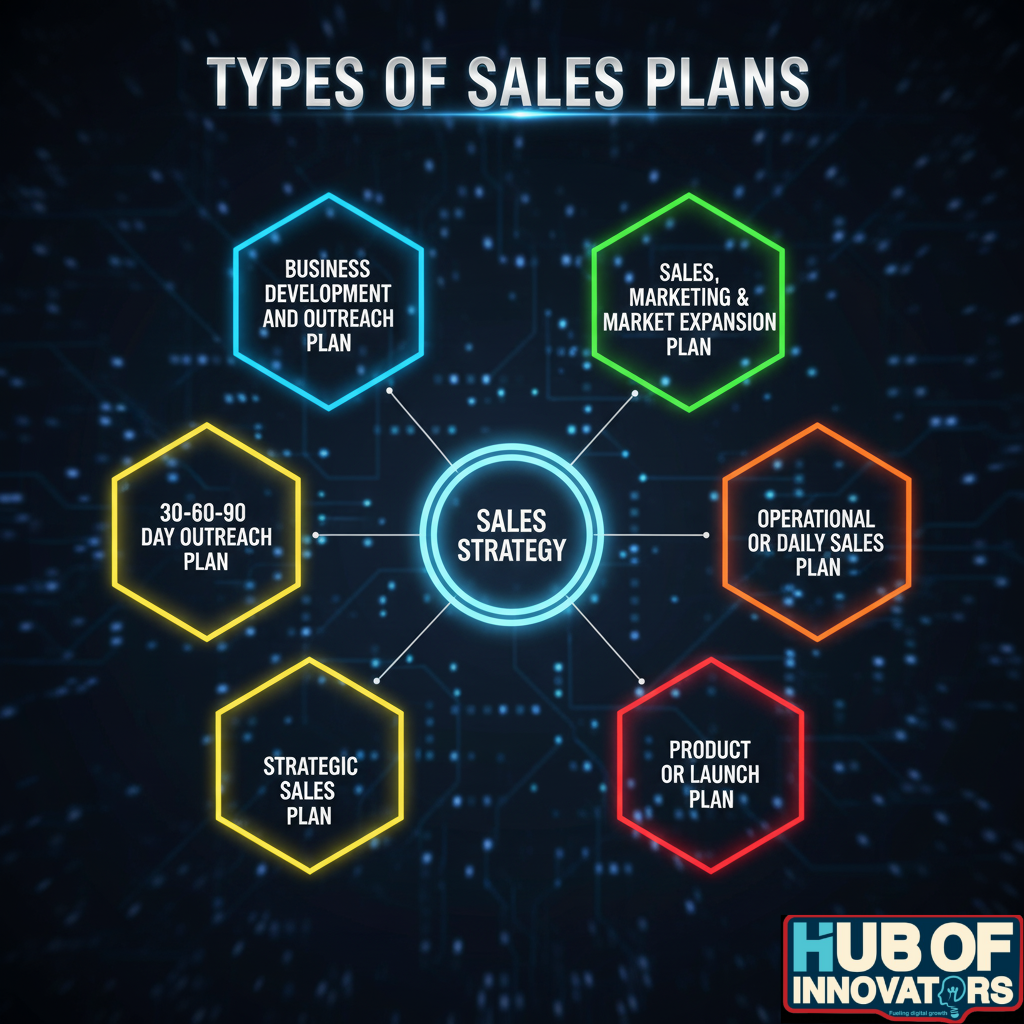Sales plan: two words that can make or break whether your business grows steadily or struggles to stay alive. A sales plan is not a piece of paper with numbers on it; it’s a roadmap that spells out how your team will reach its targets, find the most promising customers, and close the deal time and time again.
Without it, sales efforts are typically fragmented, ads fall through the cracks, resources get wasted, and growth is random. With one, your team knows what to do, when to do it, and how success will be measured.
In this guide, I’ll cover what a sales plan really is, why it matters to any company, the step-by-step process to create one, and the different types you can use.
What Is a Sales Plan?
A sales plan is a structured document that outlines your sales goals, target market, strategies, and the specific actions needed to achieve those goals. Think of it as both a map and a manual.
It includes:
- Your revenue and sales targets
- Who your ideal customers are
- The strategies you’ll use to reach them
- The daily and weekly actions your team needs to take
- How success will be measured
In short, a sales plan gives direction and focus. Instead of waking up each day wondering what to do, your team has a clear set of steps that align with the company’s objectives.

You will love this one: How to Create a Complete Marketing Strategy in 2025
Why Is a Sales Plan Important?
Without a sales plan, your business is left reacting to circumstances rather than shaping them. Here’s why it matters:
- Clarity: Everyone knows what to focus on
- Alignment: Marketing, sales, and management are all working in the same direction
- Efficiency: Time and money are spent on what is most effective
- Adaptability: A plan allows you to adjust quickly when markets change
- Accountability: Written goals and tasks make it easy to track performance
Businesses that use a sales plan are more consistent at reaching targets and less likely to waste effort on unqualified leads.
The Sales Plan Process
Developing a sales plan consists of the following:
- Assess your current situation – Review past sales data, customer feedback, and performance shortfalls.
- Set measurable goals – Define clear objectives such as revenue, new customers, or average deal size.
- Identify your target customer – Create profiles of the customers with the greatest potential to buy.
- Research competitors – Look for opportunities where you can differentiate.
- Select strategies – Choose whether to target new markets, upselling, or launching new products.
- Develop an action plan – Break strategies into actionable tasks with timelines.
- Monitor and analyze – Use KPIs such as conversion rate, cost per acquisition, or win rate to track progress.

How to Write a Sales Plan
A sales plan doesn’t have to be intimidating. The key is to make it structured and actionable. Here’s what to include:
- Executive Summary
A short overview of the plan’s purpose, the main goals, and the strategies you’ll use. - Sales Goals and Targets
Your goals should be SMART (specific, measurable, achievable, relevant, and time-bound).
Example: “Increase monthly subscription sales by 15% within six months.” - Target Market and Customer Profiles
Describe your customers in detail:- Demographics (location, income, age)
- Psychographics (values, motivations)
- Buying behaviors
- Sales Strategies
Establish the broad methods, such as:- Expanding into a new territory
- Partnering with distributors
- Offering package deals
- Launching a referral program
- Tactics and Action Steps
Translate strategies into practical actions. Example for entering a new territory:- Hire a local representative
- Translate sales materials
- Run targeted campaigns
- Sales Tools and Resources
Itemize the technology, training, and budget required. CRM systems, automation tools, and good training make a big difference. - Team Roles and Responsibilities
Assign tasks clearly. Each salesperson should know whether they’re responsible for lead generation, follow-ups, or closing. - Monitoring and Evaluation
Decide how you will measure progress. Common KPIs include:- Sales revenue
- Pipeline value
- Conversion rates
- Customer lifetime value

Sales Plan Template (Fill-in-the-Blanks)
Here’s a template you can use right away:
Executive Summary
- Purpose: ___________________________________________
- Main Goal: __________________________________________
Sales Goals and Targets
- Goal 1: ___________________________________________
- Goal 2: ___________________________________________
Target Market & Customer Profile
- Industry: __________________________________________
- Buyer Persona: _____________________________________
- Pain Points: ________________________________________
Sales Strategies
Tactics & Action Steps
- Strategy: __________________________________________
- Action 1: ________________________________________
- Action 2: ________________________________________
- Action 3: ________________________________________
Tools & Resources
- CRM: _____________________________________________
- Budget: ___________________________________________
- Training/Other: ____________________________________
Team Roles & Responsibilities
- Name: __________________ → Responsibility: __________
- Name: __________________ → Responsibility: __________
Timeline
- Key Milestones: _____________________________________
Monitoring & Evaluation
- KPIs: _____________________________________________
- Review Schedule: ___________________________________
Types of Sales Plans
Not all sales plans serve the same purpose. The best one for you depends on whether you’re onboarding a new hire, launching a product, or expanding into fresh markets. Here are some of the most effective types to consider:
1. Business Development and Outreach Plan
This plan is about creating new opportunities beyond your existing customer base. Instead of only aiming at revenue, it emphasizes partnerships, networking, referrals, and long-term relationships. Success here is often measured by the quality of leads, the strength of partnerships, and the pipeline of new opportunities created.
2. Sales, Marketing, and Market Expansion Plan
Here, sales and marketing work side by side with a shared mission: identifying the right customers and reaching them effectively. At the same time, the plan looks at expansion into new territories or customer segments. This means aligning buyer personas, adjusting messaging, and tailoring strategies for new regions.
For example, entering a new country might require translation, pricing adjustments, or forming local partnerships. The power of this type of plan is that it avoids silos: sales, marketing, and expansion efforts all push in the same direction.
3. 30-60-90 Day Sales Plan
This plan breaks the first three months into clear stages:
- First 30 days: Focus on training, learning, and observing.
- Next 30 days: Start prospecting, testing approaches, and building relationships.
- Final 30 days: Actively chase targets and aim for measurable results.
It’s a great way to set realistic milestones, especially for new team members or when entering a new
4. Product or Launch Plan
When introducing a new product or service, this plan gives it the attention it deserves. It covers:
- Who the product is for
- How it stands out against competitors
- The launch strategy and key sales channels
- Adoption and revenue goals
It ensures your product doesn’t just enter the market but does so with a clear growth path.
5. Strategic Sales Plan
A big-picture plan that spans multiple years. Instead of focusing on short-term wins, it sets the direction for scaling—whether that means moving upmarket, entering international regions, or changing the business model entirely. It’s the most forward-looking of all sales plans.
6. Operational or Daily Sales Plan
This is the hands-on, tactical guide for sales reps. It sets activity benchmarks: calls per day, follow-ups, demo scheduling, and pipeline management. Paired with a CRM, this plan provides structure and accountability, ensuring small daily actions add up to bigger results.

Q&A
Q: How often should I update my sales plan?
A: Review it at least quarterly. Markets change fast, and your plan should too.
Q: Do small businesses really need a sales plan?
A: Yes, often even more than large ones. A plan helps them use limited resources efficiently.
Q: What’s the most common mistake when creating a sales plan?
A: Setting unrealistic targets or failing to back strategies with solid research.
Q: Should marketing be involved in the sales plan?
A: Absolutely. Sales and marketing work best when aligned.
Conclusion
A sales plan isn’t just paperwork; it’s the foundation of business growth. It brings clarity, structure, and purpose to your sales efforts. Whether you’re creating an annual plan for your whole company or a product-specific plan for a new launch, the basics remain the same: know your goals, understand your customers, and outline the steps to reach them.







